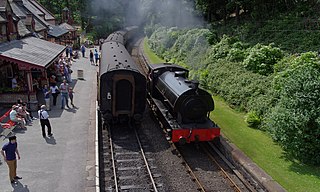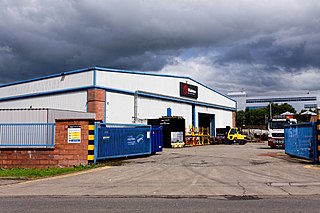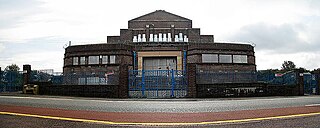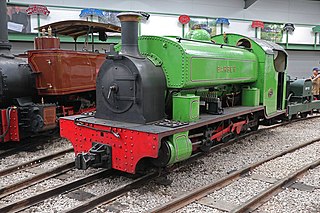
Peckett and Sons was a locomotive manufacturer at the Atlas Locomotive Works on Deep Pit Road between Fishponds and St. George, Bristol, England.

Peckett and Sons was a locomotive manufacturer at the Atlas Locomotive Works on Deep Pit Road between Fishponds and St. George, Bristol, England.

The company began trading in 1864 at the Atlas Engine Works, St. George, Bristol, as Fox, Walker and Company, [1] building four and six-coupled saddle tank engines for industrial use. They also built stationary engines and pioneered steam tramcars, the first being tested in Bristol in 1877.
Much of their output was exported, mostly 0-6-0 , with some 0-4-0 , 2-4-0 and 0-4-2 . [2] In 1878 they produced six 18 in (457 mm) gauge 2-4-2 trench engines for the Royal Engineers at Chatham using Henry Handyside's steep gradient apparatus. They also produced nine 0-6-0 ST s for the Somerset and Dorset Railway.

They were taken over by Thomas Peckett in 1880, becoming Peckett and Sons, Atlas Engine Works, Bristol. [3] The company acquired limited liability some years later. By 1900 the two companies had built over 400 locomotives.
The company continued producing a variety of small industrial and shunting engines at their factory located between Fishponds and Kingswood in Bristol. They became specialists in the field, with very precise specifications and standardisation of parts. The largest engine was an 0-8-0 built in 1931 for the Christmas Island Phosphate Company. [4] The works were served by a branch line starting just south west of Kingswood junction on the Midland line and ran for about 1 mile (1.6 km) in a generally eastward direction. It also served some collieries in the Speedwell area. [5] The only evidence remaining of this line is a bridge abutment on Whitefield Road.
During the two World Wars, the works were especially busy, but by 1950 trade had largely dried up. Although in 1956 an attempt had been made to enter the diesel-mechanical market, the last steam engine was produced in 1958 and the company was taken over by Reed Crane & Hoist Co Ltd on 23 October 1961, which itself later went into liquidation. [1]
Despite hard work and poor maintenance, the engines were long-lasting. Many Peckett locomotives survive working on today's heritage railways around the world.

The Lakeside and Haverthwaite Railway (L&HR) is a 3.2-mile-long (5.1 km) heritage railway in Cumbria, England.

The North Tyneside Steam Railway and Stephenson Steam Railway are visitor attractions in North Shields, North East England. The museum and railway workshops share a building on Middle Engine Lane adjacent to the Silverlink Retail Park. The railway is a standard gauge line, running south for 2 miles (3.2 km) from the museum to Percy Main. The railway is operated by the North Tyneside Steam Railway Association (NTSRA). The museum is managed by Tyne and Wear Archives and Museums on behalf of North Tyneside Council.
Under the Whyte notation for the classification of steam locomotives, 0-8-0 represents the wheel arrangement of no leading wheels, eight powered and coupled driving wheels on four axles and no trailing wheels. Locomotives of this type are also referred to as eight coupled.
Fishponds is a large suburb in the north-east of the English city of Bristol, about 3 miles (5 km) from the city centre. It has two large Victorian-era parks: Eastville Park and Vassall's Park. The River Frome runs through both with the Frome Valley Walkway alongside it. A restored mill found at Snuff Mills near the Vassall's Park end of the river has kept its original waterwheel, which can still be seen and heard turning. Eastville Park has a large boating lake with central wildlife reserves. Fishponds is mainly residential. Two main bus routes pass through. Housing is typically terraced Victorian. The high street shops include an international supermarket, Asian food store, charity shops, takeaways and Lidl, Aldi and Morrisons supermarkets. It has a small student population from the presence of the Glenside campus of the University of the West of England. The name Fishponds derives from when it was a quarry district, like nearby Soundwell. The empty quarries became large fishponds, which have since been filled in. One remained until the mid-1970s, when it was officially closed: a popular swimming area named "The Lido" by locals. It now belongs to an angling club.

Andrew Barclay Sons & Co., currently operating as Brodie Engineering, is a builder of steam and later fireless and diesel locomotives. The company's history dates to foundation of an engineering workshop in 1840 in Kilmarnock, Scotland.

Sentinel Waggon Works Ltd was a British company based in Shrewsbury, Shropshire that made steam-powered lorries, railway locomotives, and later, diesel engined lorries, buses and locomotives.

The Avonside Engine Company was a locomotive manufacturer in Avon Street, St. Philip's, Bristol, England between 1864 and 1934. However the business originated with an earlier enterprise Henry Stothert and Company.

Speedwell is an area of east Bristol, Part of the Hillfields ward. It has a mixture of residential and industrial land.

The Pallot Steam, Motor & General Museum is a mechanical heritage museum located in Rue De Bechet in the Parish of Trinity on the island of Jersey.
The Avonside Locomotive Works was a locomotive manufacturer on Filwood Road, Fishponds, Bristol, England. A nearby locomotive builder was Peckett and Sons located on Deep Pit Road between Fishponds and St George.

The Helston Railway is a heritage railway in Cornwall which aims to rebuild and preserve as much as possible of the former GWR Helston Railway between Nancegollen and Water-Ma-Trout on the outskirts of Helston. It is operated by the Helston Railway Preservation Company using members of the Helston Railway Preservation Society.
The Bristol and Gloucestershire Railway was an early mineral railway, opened in two stages in 1832 and 1834, which connected collieries near Coalpit Heath with Bristol, at the river Avon. Horse traction was used. It was later taken over by the Bristol and Gloucester Railway, and much of the route became part of the main line between Birmingham and Bristol, though that was later by-passed and closed. Part of it now forms the Bristol and Bath Railway Path.

The Port Elizabeth Harbour 0-4-0ST of 1894 was a South African steam locomotive from the pre-Union era in the Cape of Good Hope.
An industrial steam locomotive is a type of steam locomotive which primarily ran on industrial railways to serve a company by transporting or assisting the manufacturing products of that particular company's produce. Industrial railways often transported items such as coal, iron, slate and workers to aid production. In many countries, industrial steam serving coal mines in particular, lasted significantly longer than the nations otherwise mainline steam traction, due to the readily available fuel.

The Peckett W4 class is a class of 0-4-0 ST steam locomotives built by Peckett and Sons at the Atlas Works factory in Bristol, England from 1885 to 1906. 140 Peckett W4 locomotives were built in total, and they were part of a family of six W-class locomotive engines, which featured cylinders 14 inches (360 mm) in diameter. The W4 class has a piston stroke of 20 in (508 mm), driving wheels with a diameter of 3 ft 3+1⁄2 in (1,003 mm) and a wheelbase of 5 ft 6 in (1.676 m).

Harrogate Gasworks Railway was an industrial railway in the town of Harrogate, North Yorkshire, England. It was built to the gauge of 2 ft and ran between Bilton Junction on the North Eastern Railway, to the Harrogate Gas Company's (HGC) works at New Park, north of the town centre. It opened in 1908 to carry coal to the works for gasification, and outbound byproduct liquids. It closed to traffic in 1956. The railway was noted for its tight gauge restrictions in the tunnel at New Park. Two of its steam locomotives have survived into preservation, and are still in use on heritage railways.